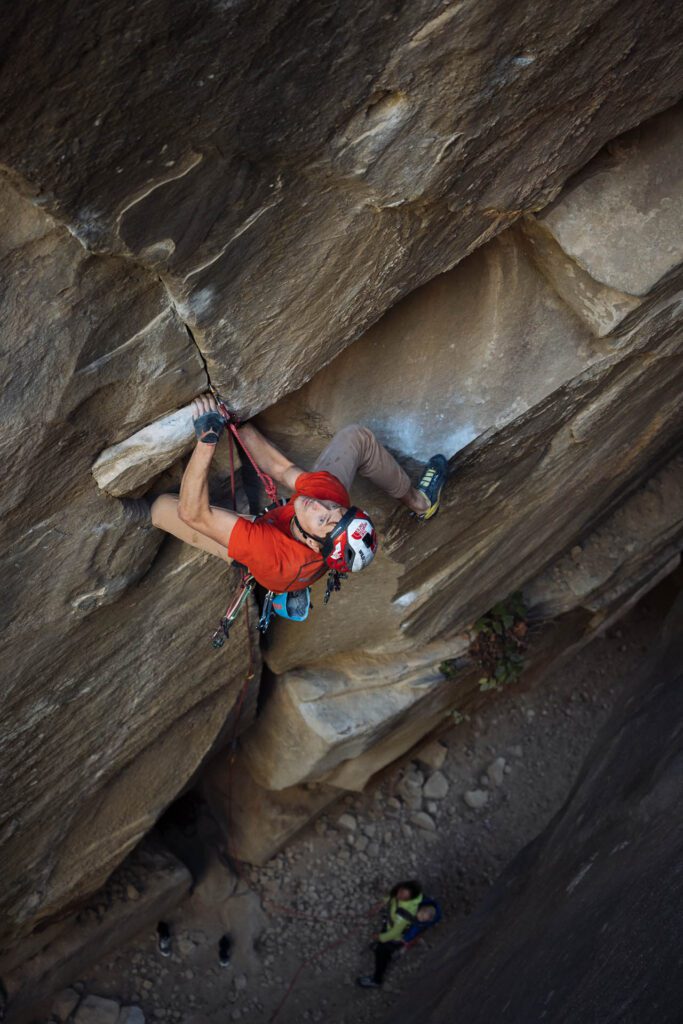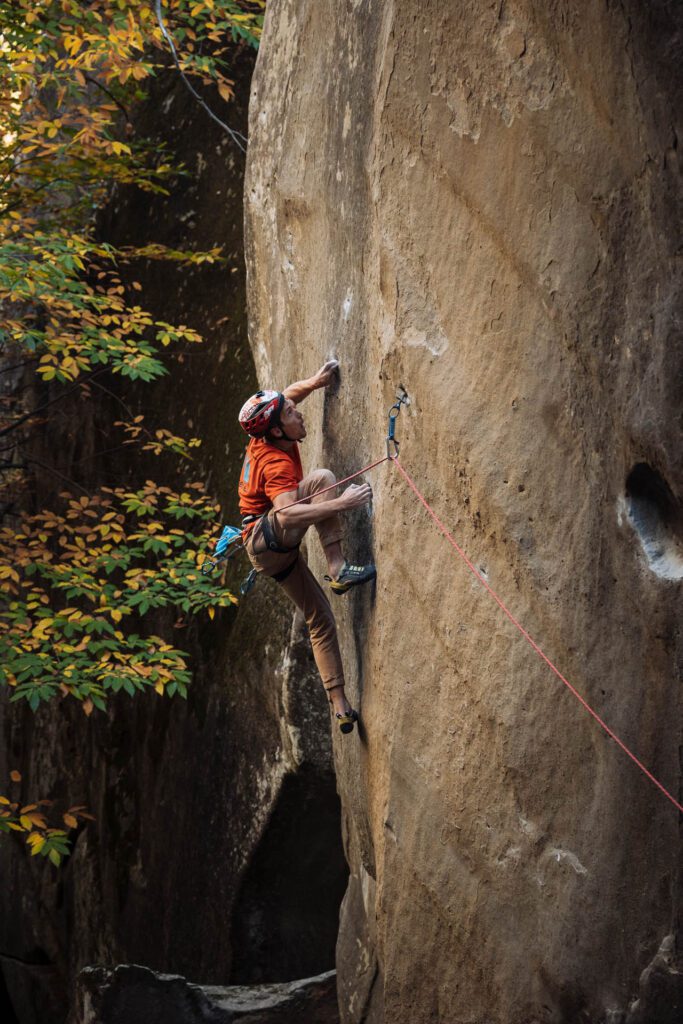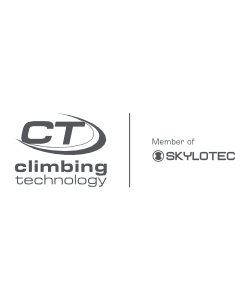James Pearson libera il suo progettone ad Annot! La trad più dura del mondo?
Il fuoriclasse del trad (e collaboratore della nostra rivista) James Pearson è riuscito a venire a capo del suo progetto di lungo periodo nella falesia francese di arenaria, Annot, dove le vie a prese scavate sono solo un ricordo del passato mentre il presente è fatto di linee trad di grande ingaggio. Foto @raphaelfourau
La nuova via condivide lo stesso inizio della prima salita di James nel 2017, “Le Voyage” (E10), prima di dirigersi a sinistra attraverso l’imponente parete bianca, attraverso una serie di buchi poco profondi, per finire su uno spigolo tecnico. James ha chiamato la sua nuova via “Bon Voyage”.
Anche se James deve ancora proporre un grado, il progetto si colloca quasi certamente tra alcune delle linee trad più difficili del mondo, avendo impiegato più tempo rispetto a qualsiasi delle sue precedenti prime salite o ripetizioni. La salita di James di Bon Voyage segue le sue ripetizioni di altre vie trad di riferimento negli ultimi due anni: “Tribe” a Cadarese, Italia e “Lexicon” (E11 7a) a Pavey Ark, Langdale, Regno Unito.
James commenta lo stile e la difficoltà della via:
” Ho trovato la linea nel 2021 e da allora mi sono preparato attivamente. Mi è sembrato un bel passo avanti rispetto ad altre vie hard trad che ho provato nel corso degli anni, ma mi è piaciuto molto il processo di sviluppo di nuove abilità e punti di forza per essere in grado di avere una possibilità.
Dopo la spaccata con Le Voyage, un primo boulder porta a un paio di buchi buoni (l’ultima protezione della via) ea un riposo marginale. Da qui ci sono 20 movimenti difficili fino alla cengia finale, quasi esclusivamente su tasche poco profonde e minuscole tacche. La via è decisamente esaurita, con lunghe cadute, ma saresti sfortunato a farti male se la protezione è ben posizionata. Annot ha alcune delle rocce più nude che abbia mai visto e le pareti possono essere spesso sabbiose e sciolte, il che significa che la maggior parte delle vie si attaccano a sistemi di fessure. Bon Voyage segue uno strato diagonale di arenaria dura come un proiettile punteggiato da minuscole sacche… un vero miracolo di Madre Natura e un promemoria del perché tutti gli anni di ricerca ne sono valsi la pena.
Questa via mi ha richiesto più tempo di qualsiasi altra via o boulder che abbia mai provato. Sia in termini di giorni di prova attiva che di tempo per prepararmi (~ 20 giorni in 2 anni e 10 per la rotpunkt).
Ho impiegato più tentativi reali di rotpunkt su questa che su Tribe e su tutte le mie altre vie sportive di 9a.
Ho dovuto allenarmi in modo specifico su un trave per essere in grado di eseguire i movimenti e collegare l’intensa sezione chiave con le dita.
Più o meno nello stesso periodo in cui ho effettuato la prima salita, ho salito un paio di 9a di lunghezza e stile simili. Mi ci sono volute circa 4 sessioni e da 4 a 5 rotpunkt. Queste vie sportive sono entrambe leggermente più strapiombanti con movimenti più facili ma peggiori riposi, quindi non congeniali per me.
Ma sono anche consapevole che: È una prima salita e si sentono sempre più difficili di una ripetizione.
Dei 20 giorni, almeno 4 sono stati spesi a spazzolare prese e cercare di capire se la linea fosse fattibile.
È leggermente fuori verticale, il che è un angolo davvero difficile da livellare. Le prese sono così piccole e povere che all’inizio i movimenti sembrano difficili, ma possono rapidamente sembrare molto più facili man mano che impari le sottigliezze di ogni posizione.
La via è su buchi, che credo siano uno dei miei punti deboli. Tuttavia, le tasche sono così poco profonde che sono più simili a pieghe (la mia forza) e, a causa dei lati della tasca, non puoi usare il pollice, quindi sei costretto a piegare a metà (la mia forza più forte tipo di presa). Mi lascia una domanda: avevo bisogno di allenarmi in modo specifico solo per raggiungere un livello medio o mi sono allenato per rendere ancora più forte la mia forza migliore? La risposta a questa domanda cambia tutto.
La mossa chiave è una percentuale molto bassa. Sono caduto molte volte su questa mossa prima di passarla, contando in modo significativo per il mio numero di rotpunkt, ma con un po’ più di fortuna avrei potuto superarla prima. Eppure, anche dopo averlo superato, sono caduto ancora 3 volte nel penultimo masso, e sono quasi caduto sull’ultimo spigolo tecnico! Non è sicuramente una meraviglia di una mossa.
Al momento non mi sento in grado di dare a questa via un grado definito, il che mi suona sempre strano perché una proposta di grado dovrebbe essere proprio questo, una proposta. In teoria dovrei semplicemente dire quello che penso, lasciando che i futuri ripetitori diano la loro opinione, e alla fine ci accordiamo. Forse sono più sensibile della persona media, ma in pratica ho visto e sentito che non funziona proprio così.
Potrei seguire il mio istinto e ricordare a me stesso che a 37 anni sono davvero troppo vecchio per preoccuparmi di cose come questa. Potrei anche sgradarlo, di fatto declassandolo io stesso prima che qualcun altro ne abbia la possibilità, ma questo ha la tendenza a portare a una stagnazione del grado come abbiamo con le vie trad nel Regno Unito, e non fa alcun favore a nessuno. Tuttavia, entrambe queste opzioni si baserebbero sul fatto che io abbia un grado fisso nella mia testa, che per tutti i motivi di cui sopra – semplicemente non l’ho ancora.
Prima di offrire un grado mi piacerebbe provare qualche via sportiva più dura per misurare meglio il mio livello, e anche salire ad Annot con altri arrampicatori di alto livello. Spero che questo mi dia un’idea migliore”.


Pearson has climbed his long-standing trad project in Annot, France.
The route shares the same start as James’ 2017 first ascent ‘Le Voyage’ (E10), before heading out to the left across the imposing blank face, via a series of shallow pockets, to finish up a technical arete.
James has named his new route ‘Bon Voyage’.
Although James is yet to suggest a grade, the project almost certainly sits amongst some of the world’s hardest trad lines, having taken James more time than any of his previous first ascents or repeats.
James’ ascent of Bon Voyage follows his repeats of other benchmark trad test-pieces in the last two years – ‘Tribe’ at Cadarese, Italy and ‘Lexicon’ (E11 7a) at Pavey Ark, Langdale, UK.
James comments on the route’s style and difficulty:
” I found the line in 2021 and have been actively preparing myself for it since then. It felt like quite a step up from other hard trad routes I’ve tried over the years, but I’ve really enjoyed the process of developing new skills and strengths to be able to stand a chance.
After the split with Le Voyage, a first boulder problem takes you to a couple of good pockets (the final protection of the route) and a marginal rest. From here there are 20 hard moves to the finishing ledge, almost exclusively on shallow pockets and tiny crimps. The route is definitely run out, with long falls, but you’d be unlucky to hurt yourself providing the protection is well placed. Annot has some of the blankest rock I have ever seen and the walls can often be sandy and loose, meaning most of the routes stick to crack systems. Bon Voyage follows a diagonal layer of bullet hard sandstone dotted with tiny pockets… a true miracle of Mother Nature and a reminder why all the years of searching were worth it.
This route took me longer than any other route or boulder I’ve ever tried. Both in terms of days actively trying it and time preparing myself for it (~ 20 days over 2 years and 10 redpoints).
I spent more actual redpoint attempts on this than on Tribe, and all of my other 9a sport routes.
I had to train specifically on a fingerboard to be able to do the moves and link the intense, fingery crux section. Around the same time I made the first ascent, I climbed a couple of 9a’s in a similar length and style. These took me around 4 sessions and 4 to 5 redpoints. These sport routes are both slightly more overhanging with easier moves but worse rests, and shouldn’t suit me as well.
But I’m also aware that:It’s a First Ascent, and they always feel harder than a repeat.
Of the 20 days, at least 4 of them were spent brushing holds and trying to understand if the line might be possible.
It’s slightly off-vertical which is a really difficult angle to grade. The holds are so very small and poor, that the moves feel difficult at first, but can quickly feel much easier as you learn the subtleties of each position.
The route is on pockets, which I believe to be one of my weaknesses. However, the pockets are so shallow (less than half pad) that they are more like crimps (my strength), and because of the sides of the pocket, you can’t use your thumb so you are forced to half crimp (my strongest grip type). It leaves me questioning: Did I need to train specifically just to reach an average level, or did I train to make my best strength even stronger? The answer to this question changes everything.
The crux move is very low percentage. I fell many times on this move before passing it – counting significantly towards my number of redpoints, but with a bit more luck I might have passed it sooner. Still, even after passing it I still fell 3 times in the 2nd to last boulder, and almost fell on the final technical arête! It’s definitely not a one move wonder.
At the moment I don’t feel able to give this route a definite grade, which always sounds funny to me as a grade proposal should be just that, a proposal. In theory I should simply say what I think, leaving future repeater’s to give their opinion, and eventually we settle on a consensus. Perhaps I’m more sensitive than the average person but in practice I’ve seen and felt that it doesn’t quite work like that.
I could go with my gut and remind myself that at 37 I’m really too old to worry about things like this. I could also under grade it, effectively downgrading it myself before anyone else gets the chance, but this has a tendency to lead to grade stagnation like we’ve got with trad routes in the UK, and doesn’t do anyone any favours. However, both of these options would rely on me having a fixed grade in my head, which for all the above reasons – I simply don’t, yet.
Before offering a grade I’d like to try a few more hard sport routes to better gauge my level, and also climb at Annot with other high-level climbers. Hopefully this will give me a better idea.”


Comments are closed.